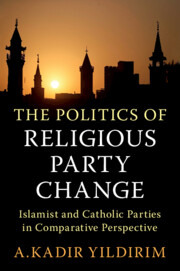Book contents
- The Politics of Religious Party Change
- Cambridge Studies in Social Theory, Religion, and Politics
- The Politics of Religious Party Change
- Copyright page
- Contents
- List of Figures
- List of Tables
- Acknowledgments
- Introduction
- 1 Explaining Religious Party Change
- 2 Catholic and Islamic Religious Institutions
- 3 Anticlericalism, Religious Revival, and the Rise of Religious Political Identities
- 4 The Origins of Religiopolitical Identity
- 5 Intraparty Conflict
- Conclusion
- Bibliography
- List of Interviews
- Index
4 - The Origins of Religiopolitical Identity
Published online by Cambridge University Press: 22 December 2022
- The Politics of Religious Party Change
- Cambridge Studies in Social Theory, Religion, and Politics
- The Politics of Religious Party Change
- Copyright page
- Contents
- List of Figures
- List of Tables
- Acknowledgments
- Introduction
- 1 Explaining Religious Party Change
- 2 Catholic and Islamic Religious Institutions
- 3 Anticlericalism, Religious Revival, and the Rise of Religious Political Identities
- 4 The Origins of Religiopolitical Identity
- 5 Intraparty Conflict
- Conclusion
- Bibliography
- List of Interviews
- Index
Summary
The politicization of religion and emergence of a religious political identity in the modern era is firmly anchored in the rise of mass religious movements – a hitherto unknown phenomenon. These movements became the main instruments for fulfilling the newly developed religious sociopolitical vision. Not only did they play a crucial role in raising a religious generation to confront social change and secularization, but they also aimed to confront deviant ideologies and remake the political system in line with their religious visions. In this distinctly political objective lie the seeds of religious political parties, which carry the missions of religious mass movements into the political arena. Religious movements embody the ideal organizational form of modern religiopolitical activism – they can lay out a vision for societal and political transformation, teach and preach this vision, and mobilize resources and communities to achieve it. These movements translated the bourgeoning religious responses to modernization and secularization into tangible social, religious, and political agendas. This chapter analyzes the emergence of mass religious movements in the Middle East and Western Europe.
Keywords
- Type
- Chapter
- Information
- The Politics of Religious Party ChangeIslamist and Catholic Parties in Comparative Perspective, pp. 110 - 189Publisher: Cambridge University PressPrint publication year: 2023

